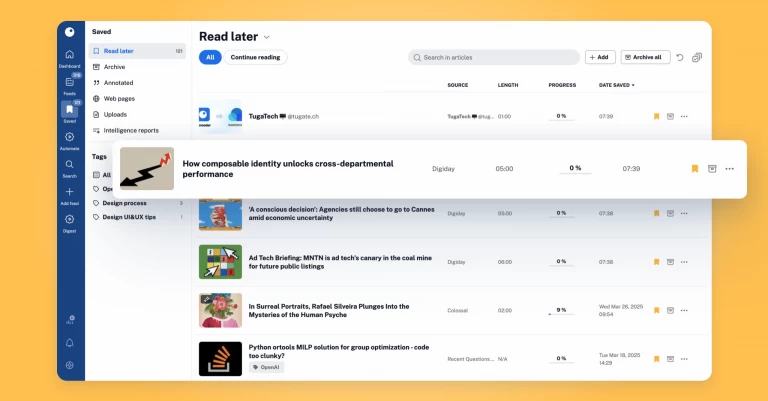7 Ways You Can Use RSS Feeds To Improve Your Business

Even under normal circumstances, a day’s workload can appear insurmountable, if you’re involved in marketing, SEO or any other position where content management is essential.
During a global pandemic that has caused an upheaval in how we live our lives and put us under a considerable amount of psychological pressure day in and day out, what we achieve regularly is just too much.
Changes to how we approach work need implementing and RSS is the tool to reduce the amount of work one has to perform in a day. All thanks to removing repetitive, menial tasks that thieve precious minutes and interrupt your thinking throughout the entire work day.
How can businesses benefit from RSS?
RSS might seem like a background feature that’s gone out of fashion, but in the right user’s hands RSS becomes a powerful way to manage heavy information flows on a daily basis.
And what’s the Internet of today other than having to hold your own against new posts popping up in your feed, fresh newsletters in your inbox and distracting notifications from every social media platform you’re currently using.
Put a stop to all distractions, which harm your workflow and interrupt your concentration, through RSS feeds.
What is RSS and how does it work?
Time to cover the basics. RSS is abbreviated from ‘really simple syndication’ (you can also see it as ‘rich site summer’) and refers to an online file within the source code of a site, which contains details about every piece of published content. RSS feeds are coded in XML and whenever an RSS reader crawls over the feed it pulls any new posts published on the site, arranging them in a linear, chronological order together with updates from other sites.
RSS readers display only the most crucial information about an article: publication date, author and title, link and a brief excerpt of the article itself. There could be a text summary. Sometimes, readers provide users with the functionality to read entire articles without directing to the site, but bear in mind most multimedia files will not be displayed.
The benefits of RSS
RSS was conceived as a productivity tool to assist in managing the publication schedules of multiple sites and blogs. Its popularity may very well have been two decades ago, but RSS still lives up to its purpose in today’s digital landscape ruled by incomprehensive algorithms and content spread over numerous publication platforms:
- No algorithms change the order of publication for you. Social media was once useful for this very purpose, but now it’s all jumbled out of order. RSS readers can host feeds from social media channels including YouTube.
- Consolidate every type of content of your interest in one place, even newsletters, and then filter and organize as you see fit to ensure you experience content in the best way possible.
- Site owners can foster loyal readership by introducing RSS feeds. If you’re covering many topics, you can even create your own custom RSS feeds.
Why are RSS feeds so important?
No matter where you are on the content production chain, there’s always a means to harness RSS to improve your performance and increase your productivity in a significant way. Paired with tools like Zapier, Google Alerts and social media sharing platforms like Hootsuite, you’re able to fully automate how you read and disseminate information online.
Because RSS syndicates content you have a lot more freedom to curate a personal newsletter for internal use in the company. If you’re on a very busy publishing schedule, then you’re able to schedule tweets through Hootsuite and easily click and share multiple posts without having to go through each post individually. Complement RSS with Post Planner and you have a handy tool to analyse content performance one feed at a time. Useful not just to identify social engagement on your own posts, but other RSS feeds as a way to generate insights into what the public enjoys.
Content aggregation remains a strong component of how content is distributed. Entire websites are run on the content of others, and it’s also not uncommon for smaller sites to feature RSS feeds of news and other relevant information for their readership. Serving readers is the main objective and having an RSS feed (or multiple custom RSS feeds) adds another layer of convenience for those readers who want a hands-on approach to structuring their reading.
7 ways to improve your business with RSS
Thinking of RSS feeds as just another way to structure your reading is reductive. You’re only at the surface of what the current generation of RSS readers can accomplish with the right settings and filters.
From monitoring feeds to optimizing your inbox, RSS readers can perform quite a few feats of their own.
Find relevant content
Any industry has its trade publications and experts who report on crucial developments. Perhaps you wish to research a specific topic? Or maybe source content for an aggregator site you own?
RSS keeps your reading organized so you have all possible blogs and magazines in one place so you never miss out on content. At the same time, RSS readers help you expand on your search. Inoreader complements user experience with an internal search function, which can recommend new materials in related topics. All without your previous search history influencing your overall search results.
In many cases RSS readers tend to recommend popular RSS within central categories such as tech, film, art, culture and science. In seconds, you’re able to build on top of your site list.
Optimize your email digests
Email subscriptions worked best when few sites presented readers with the option to subscribe and the service functioned as a substitution of RSS.
However, newsletters have outlasted their welcome due to a) every website in existence promotes its newsletters (also find sneaky ways to make you subscribe through free guides), and b) it’s not uncommon for a single site to bombard you with multiple digests per week. Sometimes per day.
That is no way to treat your inbox. Raise your hand honestly, if you’ve managed to stay on top of work email and read every single newsletter. How many of those newsletters actually link to an article(s) worth your time? The answer is disappointing.
RSS readers liberate you from the constant spam, directs your attention to the content that matters and aids you in achieving the mythic inbox zero.
Monitor media and engage with customers
Social media channels and accounts have also been added to the catalog of content RSS readers monitor, so you never miss out on what’s happening on Twitter, Facebook or Instagram.
Whether it’s for your own brand and staff or any other important entity in your industry, you can stay on top of the latest posts when they’re published. We’re not the only ones dissatisfied with the introduction of non-chronological feeds. RSS readers can be integrated with third-party clients like Zapier, which can produce customized RSS feeds based on a list of accounts.
Monitoring social media and your social media handles gives you an opportunity to address your audience in meaningful ways. You should already be practicing social media monitoring in order to identify customer pain points and improve your product over time.
Take care of your online reputation
RSS is a multipurpose tool waiting for you to discover its full capabilities. One such unexpected application comes in the form of monitoring your brand reputation online.
As a rule of thumb, you have to be aware of what customers, industry professionals and competitors are saying about you. This is what we call public sentiment – the attitude and level of good will that is extended towards you as a corporate entity. Knowing public opinion is the first step towards either changing it or strengthening it.
Without the solid budget allocated for a monitoring tool, you can resort to a classic setup. Create a series of Google Alerts based on all branded keywords (brand name, products, slogans) and then rather than receive them in your inbox, simply subscribe to them via RSS. Google Alerts generate their own unique RSS feed so the process is fairly simple. What’s best is you didn’t have to pay a single cent for the service.
Improve your marketing efforts
The knowledge you gain through all the practices above reveals where you can improve in order to position your products better. You also understand more about your audience and what strengths you can place front and centre in your messaging.
In the end, successful marketing hinges on a solid value proposition and RSS supplies you with the information needed to define it best.
Spot trends in your industry
Once you have subscribed to all relevant publications and information sources, whether on social media or newsletter, it’s time to organize based on topic. Filtering and other automation tricks to improve your overall RSS experience group your content by topics, which helps you identify any patterns to what you’re reading.
Industries vary significantly, so I can’t speak towards the speed at which trends form. However, I can speak towards the efficiency at which you’ll spot them through RSS. Using RSS enables you to review substantially more articles at a glance, so you’ll spot when a wave of similar headlines hits your industry. Given the frequency of such occurrences, Inoreader has developed ‘Duplicate Filter’. Its initial functionality was to remove identical titles, but now has evolved to encompass near duplicates.
Keep track of your competition
Competitors are the benchmark against which you have to perform. It pays to study market leaders and also very useful to keep an eye on up-and-comers, which might challenge your position. The triumphs and failing of your competition reveals market opportunities, winning strategies and the pitfalls one must avoid to maintain a solid reputation.
Lessons to be learned from different information channels:
- Social Media Pages: What are they saying and what engagement do they receive from their audience? What are their branded hashtags? When are they launching a new product? Are they preparing for a new campaign? The answers guide you around big publicity events so you can shine in your own time and investigate how their marketing worked.
- Industry publications: Whenever competitors get mentioned in trade blogs and magazines, it’s a chance to understand professional sentiments.
- Google Alerts: Who are mentioning them outside social media? What are they saying? Are they linking to their site? Is that an opportunity to develop your own link building strategy.


